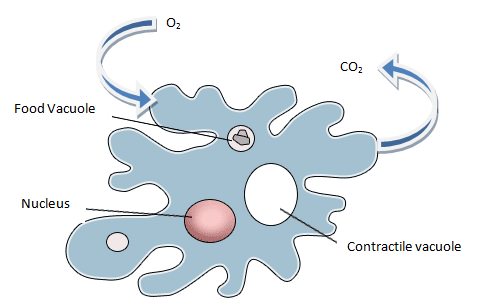Different animals have different types of respiratory organs which uptakes oxygen and removes carbon dioxide out of body. For example, in unicellular organisms such as amoeba and paramecium exchange of gases takes place through plasma membrane by simple diffusion. In earthworm, leech and frogs exchange of gases takes place through their moist skin. In insects such as grasshopper and cockroach respiration is done through spiracles and trachea. In aquatic animals such as fish respiration takes place through special respiratory organs called gills. While in all the land animals such as birds, dog, cat, cow and humans respiration takes place through special respiratory organs called lungs. Now, we shall discuss respiration in amoeba, insects, earthworm, fish and human beings in detail.
Respiration in Amoeba
We know that amoeba is a unicellular organism which lives in fresh water. This organism does not have a specialized organ to do the process of respiration. So in amoeba respiration takes place through its cell membrane also called plasma membrane. Amoeba gets oxygen gas dissolved in surrounding water through its plasma membrane by the process of diffusion. The oxygen gas diffused inside the body is used up by amoeba. In the body the oxygen gas absorbed is used to break down the complex food material into simple molecules. During these metabolic reactions in the body of amoeba the oxygen gas is converted into carbon dioxide gas. The carbon dioxide gas is also liberated in the surrounding water through the same process of diffusion.

Test Your Understanding and Answer These Questions:
- In which animal gills are found?
- Explain the process of respiration in amoeba.
- From where do Prawn and Rat take in oxygen?
- Write the names of three animals which respire through skin.
- Write the names of two animals which respire through plasma membrane.
- Name the respiratory organs of 1. Fish 2. Mosquito 3. Earthworm and 4. Dog.
